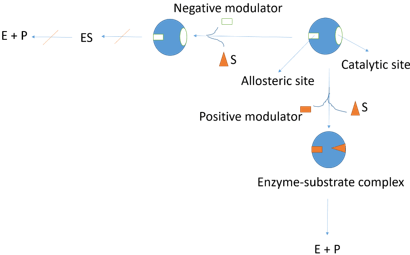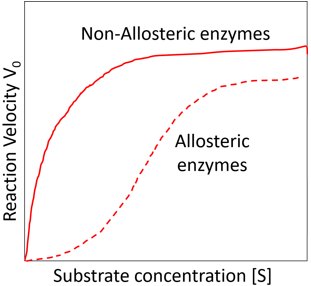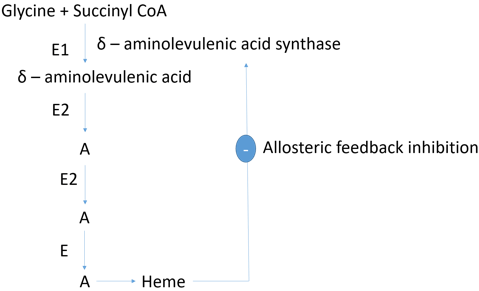This set of Enzyme Technology Multiple Choice Questions & Answers (MCQs) focuses on “Allosteric Enzyme”.
1. Which of the following is not true for allosteric enzyme?
a) Greek word ‘allo’ means other and ‘steros’ means site
b) Enzymes having other site
c) Regulatory metabolites are called effector or modulator or modifier
d) Each of two or more enzymes with identical function but different structure
View Answer
Explanation: “Each of two or more enzymes with identical function but a different structure.” This statement is not true for allosteric enzymes as it is defining isoenzyme. The following statements are true for allosteric enzymes:
• Greek word ‘allo’ means other and ‘steros’ means site.
• Enzymes having other sites.
• Regulatory metabolites are called effector or modulator or modifier.
2. The enzymes having allosteric sites, other than catalytic site which is used for binding for regulatory metabolites is referred to as _________
a) isoenzyme
b) biosensor
c) allosteric enzymes
d) effectors
View Answer
Explanation: The enzymes having allosteric sites, other than catalytic site which is used for binding for regulatory metabolites is referred to as allosteric enzymes. Each of two or more enzymes with identical function but different structure is known as isoenzyme. An analytical device which converts a biological response into an electrical signal is referred to as a biosensor. Regulatory metabolites required for binding to allosteric sites are called effectors.
3. Effectors that inhibit enzyme activity are termed as ____________
a) positive effectors
b) modulators
c) negative effectors
d) inhibitor
View Answer
Explanation: Effectors that inhibit enzyme activity are termed as negative effectors. Whereas those increase the enzyme activity are referred to as positive effectors. Regulatory metabolites are called modulator or modifier or effector. Substances which causes reduction in the rate of an enzyme catalyzed reaction is known as inhibitor.
4. ________ is referred to as effectors which increase the enzyme activity.
a) Positive effectors
b) Modifier
c) Negative effectors
d) Inhibitor
View Answer
Explanation: Positive effectors is referred to as effectors which increase the enzyme activity. Effectors that inhibit enzyme activity are termed as negative effectors. Inhibitor is referred to as those substances which causes reduction in the rate of an enzyme catalyzed reaction. Regulatory metabolites are called modulator or modifier or effector.
5. What is represented in the following diagram?

a) Induced fit model
b) Mechanism of allosteric enzymes by modulators
c) Biosensor
d) Fluidized bed reactor
View Answer
Explanation: In the above diagram, mechanism for inhibition and stimulation by modulators of allosteric enzyme is shown. When negative modulators are involved the substrate is removed from the catalytic site, hence no ES complex formed, hence no product. During the use of positive modulators, the positive modulator attaches to its allosteric site and encourages more substrate to bind to the catalytic site forming ES complex and hence more product is formed.
6. What is represented in the diagram?

a) Effect of temperature versus activity of enzyme
b) Effect of pH versus activity of immobilized enzyme
c) Effect of substrate concentration on reaction velocity for an allosteric enzyme
d) Effect of temperature versus activity of allosteric enzyme
View Answer
Explanation: In the above diagram, a plot depicting effect of substrate concentration on reaction velocity for an allosteric enzyme. Allosteric enzymes are the enzymes having allosteric sites, other than catalytic site which is used for binding for regulatory metabolites. Allosteric enzymes do not obey Miachelis-Menten kinetics. Hence a sigmoidal curve is observed instead of a hyperbolic curve.
7. Which of the following is not an inhibitor of pyruvate dehydrogenase in conversion pyruvate to acetyl CoA?
a) Citrate
b) ATP
c) NADH
d) Acetyl CoA
View Answer
Explanation: Citrate acts as activator for acetyl CoA carboxylase in fatty acid synthesis. Inhibitors of pyruvate dehydrogenase in conversion pyruvate to acetyl CoA are ATP, NADH and Acetyl CoA.
8. Which of the enzyme ATP does not act as an inhibitor?
a) Isocitrate dehydrogenase
b) Phosphofructokinase-1
c) Glycogen phosphorylase
d) Fructose-1,6- bisphosphatase
View Answer
Explanation: For, fructose-1,6- bisphosphatase, ATP does not act as an inhibitor, but activator in gluconeogenesis pathway. ATP is used as inhibitor for the following enzymes:
• Isocitrate dehydrogenase in the TCA cycle.
• Phosphofructokinase-1 in glycolysis cycle.
• Glycogen phosphorylase in glycogenolysis.
9. Which of the following is not true of feedback allosteric inhibition in multienzyme system?
a) First enzyme of the sequence is regulatory allosteric enzyme
b) The enzyme is inhibited by the end product of the multienzyme system
c) Allosteric enzymes obey Miachelis-Menten kinetics
d) The whole enzyme system slows down to bring the rate of production of its end product back into balance when the cell needs it
View Answer
Explanation: “Allosteric enzymes obey Miachelis-Menten kinetics.” This statement is not true for allosteric feedback inhibition. The following statements are true for feedback allosteric inhibition in multienzyme system:
• First enzyme of the sequence is regulatory allosteric enzyme.
• The enzyme is inhibited by the end product of the multienzyme system. Thus, the end product of the sequence acts as a specific inhibitor of the first regulatory enzyme in the sequence.
• The whole enzyme system slows down to bring the rate of production of its end product back into balance when the cell needs it. This type of regulation is called feedback allosteric inhibition.
10. What is represented in the following diagram?

a) Mechanism of allosteric enzymes by modulators
b) Allosteric feedback inhibition
c) Induced fit model
d) Biosensor
View Answer
Explanation: In the above diagram, allosteric feedback inhibition is represented. In allosteric feedback inhibition, the enzyme is inhibited by the end product of the multienzyme system. This leads to slowing down of the whole enzyme system to bring the rate of production of its end product back into balance when the cell needs it. In this case, the first enzyme, δ-aminolevulenic acid synthase is an allosteric enzyme that is inhibited by its end product heme.
Sanfoundry Global Education & Learning Series – Enzyme Technology.
To practice all areas of Enzyme Technology, here is complete set of 1000+ Multiple Choice Questions and Answers.
If you find a mistake in question / option / answer, kindly take a screenshot and email to [email protected]
- Practice Chemical Engineering MCQs
- Check Biotechnology Books
- Apply for Chemical Engineering Internship
- Practice Biotechnology MCQs
- Check Enzyme Technology Books
